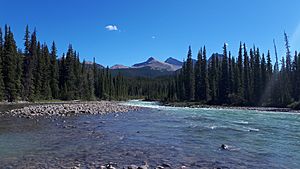Snake Indian River facts for kids
Quick facts for kids Snake Indian River |
|
|---|---|

The Snake Indian River in Jasper National Park
|
|
| Country | Canada |
| Province | Alberta |
| Physical characteristics | |
| Main source | Snake Indian Pass 2,128 m (6,982 ft) 53°19′03″N 118°57′06″W / 53.31750°N 118.95167°W |
| River mouth | Athabasca River 1,039 m (3,409 ft) 53°11′04″N 117°59′12″W / 53.18444°N 117.98667°W |
| Length | 115 km (71 mi) |
The Snake Indian River is a big river that flows into the Athabasca River. It's completely inside Jasper National Park in Canada. This river starts high up at Snake Indian Pass. It's found near Monte Christo Mountain and Snake Indian Mountain.
The river first flows towards the northwest. Then, it makes a sharp turn and heads south. The Snake Indian River drops over the huge Snake Indian Falls. Finally, it joins the Athabasca River near the east gate of Jasper National Park. This meeting point is just past Jasper Lake.
Why is it Called Snake Indian River?
The Snake Indian River, along with Snake Indian Mountain and Snake Indian Pass, got its name from a group of Indigenous people. These people were called the Snakes. They lived around a place called Jasper House in the 1800s.
In some Indigenous cultures, the word snake was sometimes used to describe other tribes. This happened even if the tribes were not related. That's why you might find many places in Alberta named "Snake" where different groups of Indigenous people lived. The "Snakes" who lived north of Jasper had a difficult time. They were involved in a conflict with a group called the Assiniboines.
Rivers and Streams Joining the Snake Indian River
Several smaller rivers and streams flow into the Snake Indian River. These are called tributaries. They add more water to the main river as it flows.
- Blue Creek
- Deer Creek
- Willow Creek

